Empire: Total War Review
Empire: Total War
If you thought that the Total War series couldn't get any better, think again.
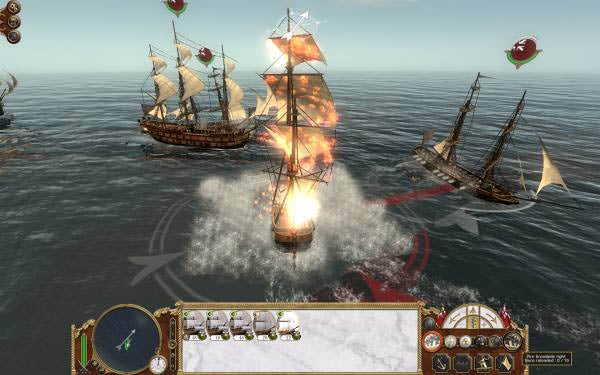
Verdict
Key Specifications
- Review Price: £23.96
”’Platform: PC”’
Frankly, it’s almost too big to review. Give me a month off work and 10,000 words to play with, and I might just be able to give you a final and definitive verdict on Empire: Total War. As things are, you’ll have to settle for my honest opinion of the game as I’ve experienced it, and bear in mind that there are huge sections of The Creative Assembly’s latest opus that I’ve had to leave virtually untouched. More and more I feel that the Total War series isn’t just a series of games, but a virtual cathedral to epic strategy, each instalment resting on and building from the foundations, walls and towers put in place by the last. Even for those of us familiar with the series, beginning a new one can be an intimidating business. For anyone new, Empire: Total War might feel terrifyingly detailed and complex.
It doesn’t have to be though. Beneath all the features and complex game mechanics, Empire remains a mix of turn-based empire building and real-time strategy, these two elements kept separate but affecting each other throughout the game. In the one half, you’re developing your cities, raising and moving armies and sending out agents to spy, sabotage or steal technology on your behalf. You also have to maintain diplomatic relations with allies and rivals, steer scientific progress to develop new military, social and technological assets, and ensure that your economy remains headed in the right direction. When conflict rears its ugly head – and inevitably it will – it’s time for the other half of the game to take over. This is the 3D real-time strategy that you’ll remember from previous Total War games or the BBC programme Time Commanders; a fast-paced, realistic simulation of warfare featuring dozens of units and thousands of men on the field at any one time. 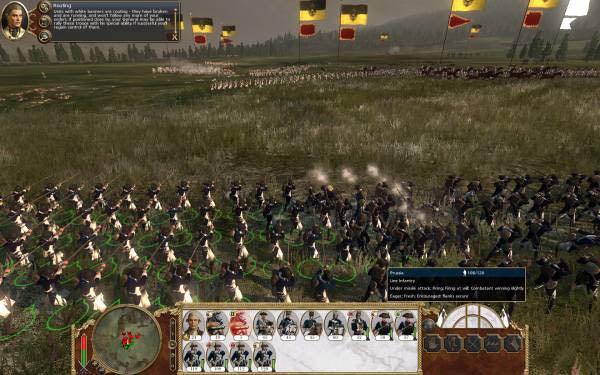
It’s a mix designed to satisfy would-be Bismarcks and would-be Napoleons, and the game cleverly allows you to play the way you like best. Handling both portions gives you the full, rich Total War experience, but if you want to let the AI handle the management of the economy and the society, you can. If you want to let battles resolve themselves and concentrate on the political drama, then that’s fine too. If you want, you don’t even have to spend a second in the central ‘Grand Campaign’; you can just set up your own battles or play the pre-defined scenarios, and just enjoy the sounds of booming cannon, musket-fire and clashing steel.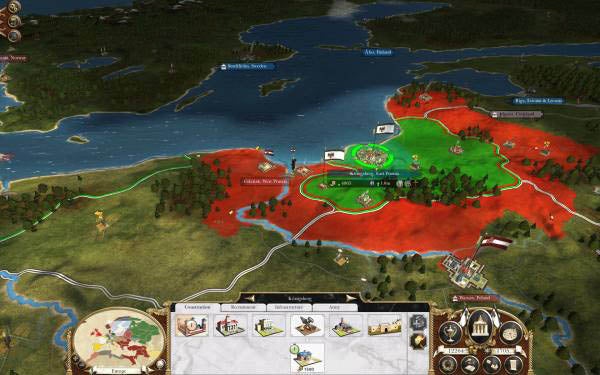
I had my doubts about Empire’s 18th Century setting, but I really needn’t have worried. This is an exciting period of European colonial expansion and internal conflict, taking in events that will be familiar to anyone who’s read Neal Stephenson’s excellent (if equally intimidating) Baroque Cycle, and leading up to the Napoleonic wars and the wars of German and Italian unification that will dominate the century to follow. If your nearest reference point is Sharpe, don’t worry. The weaponry and tactics work along similar lines, and you’ll still have a pretty good idea of who is siding with whom. The important thing is that it’s a vivid period with a lot going on, and that – as a result – there’s an awful lot of meat in Empire to chew on. 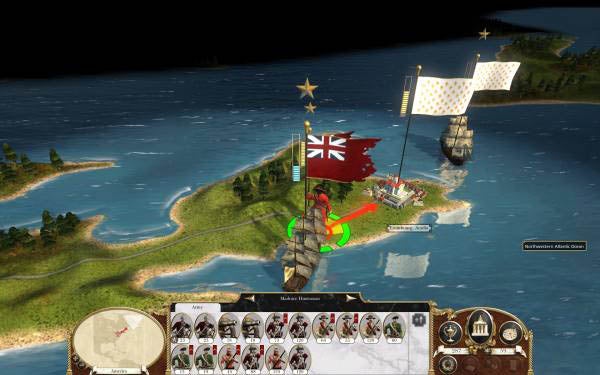
Playing as glorious Blighty, for example, you really have your hands full. Not only must you guard against attack from the forces of France and Spain, but the action now stretches across three distinct theatres, taking in not just Europe, but the American colonies (full of treacherous rebels who don’t like tea, or something) and the Indian subcontinent (where two rival Empires need sorting out, in good old-fashioned Imperialist style). That’s an awful lot of plates to keep spinning, and it’ll take a superb grasp of economic and military strategy and detail if you want to even have a hope of winning through.
Too much to contend with? Try the Prussian campaign. The Kaiser and his chums have control of two regions, inconveniently divided by a large chunk of Poland. Wouldn’t it be better if you could just join the whole lot up, and maybe annexe the rest of Germany while you’re at it? Isn’t it time you showed the Austrians who’s boss? When you bear in mind that these are only two of the twelve playable factions, each with their own objectives, it’s pretty obvious that this is a really extensive game.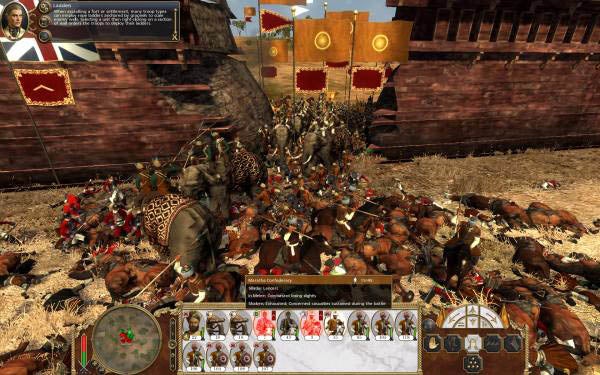
I think The Creative Assembly realised that the scope and scale of the Grand Campaign made it a little daunting for newcomers, so the game also features a more accessible campaign reminiscent of those introduced by the Medieval 2: Kingdoms expansion, following the growth of the US colonies towards settlement and independence. This starts off simple with the basics of the game and drip-feeds new concepts and game mechanics in as it goes on, taking you from your first towns through to your first conquests, diplomatic alliances, agents and onwards. For many games this would be THE main single-player campaign, so when I tell you that it’s best seen as a gentle introduction to Empire: Total War, you get some idea of how huge the main game is.
Bigger than the already colossal Medieval 2? Amazingly, yes. Not only does the introduction of the two new theatres add extra weight to the game, but there’s a new focus on seafaring activity. This means sea trade and piracy, plus the ability to exploit new trade theatres (and prevent other nations from doing so). However, it also leads us to the game’s big headline feature, Empire being the first Total War with naval combat. 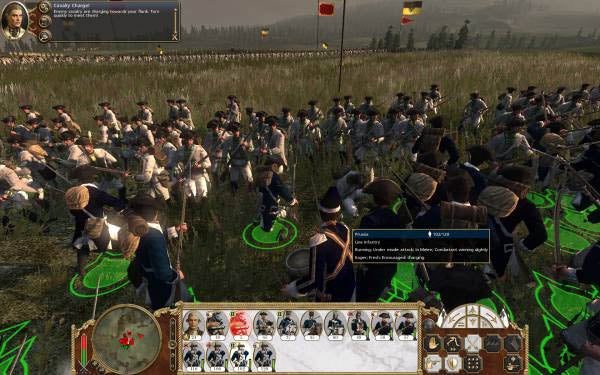
Expert opinion is currently divided on how successful this new expansion is, and naval combat certainly seems a little haphazard and messy in comparison to Empire’s land-based battles. All the same, there’s still plenty of scope for strategy and detailed control here, particularly once you get into the intricacies of turning the ship, switching ammunition types and firing broadside cannonades. More importantly, the naval action is heavy on atmosphere, capturing the same kind of nervous tension and noisy release that you might remember from Hornblower or Master and Commander. The lack of scenery can make naval encounters somewhat samey – I’ve yet to see one take place with land in sight – but they’re an entertaining addition to the Total War formula, and one that The Creative Assembly will doubtless improve upon in the future.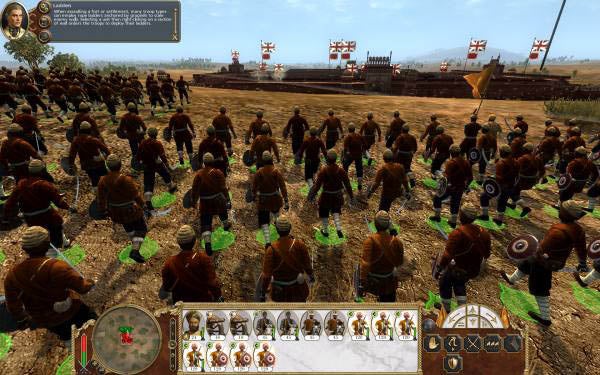
Otherwise, we get a host of tweaks and enhancements, ranging from a new relationship between agents and buildings (now certain buildings effectively spawn certain types of agent) to the new ability of some agents (say, the rake) to dispose of enemy agents (say, the all-new Gentleman, who doubles as scholar and duellist). Diplomacy is now a more complex business, as befits the period, and technological progress has a far greater impact on the buildings you can construct and the units you can manufacture. More plates to spin, in other words.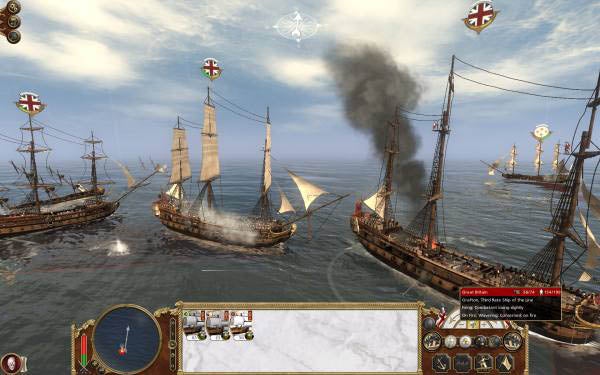
Needless to say, the change of period also has a huge impact on the action on the battlefield. Infantry formations and cavalry charges still have a vital part to play, and siege warfare remains a key part of the overall picture, but the new dominance of the musket and artillery on the battlefield soon affects the whole way you play the game, making you much more careful about how you attack heavily defended positions, and making you think seriously about the way you deploy and control your musket-wielding units. Again, this kind of thing will be familiar from Sharpe on the telly, and it’s interesting to note how new advances in the turn-based Grand Campaign affect your troop’s efficiency in combat. If you thought you’d mastered the tactical aspects of Total War, prepare to think again.
The AI is generally improved across the board, with enemies less likely to be sucked out of a strong position by obvious feints, and less oblivious to sudden assaults or outflanking manoeuvres than in previous games. My one big complaint is still pathfinding. In a couple of cases key allied units cheerfully absented themselves from battle by taking such painfully roundabout routes to, say, attack an artillery unit, that they completely missed the action altogether. When you win anyway, this isn’t a disaster, but in situations where every single unit counts, this can be hugely aggravating, not least because the minutes you’ll waste micro-managing these twits would be better spent handling troops who have made it into the fray. 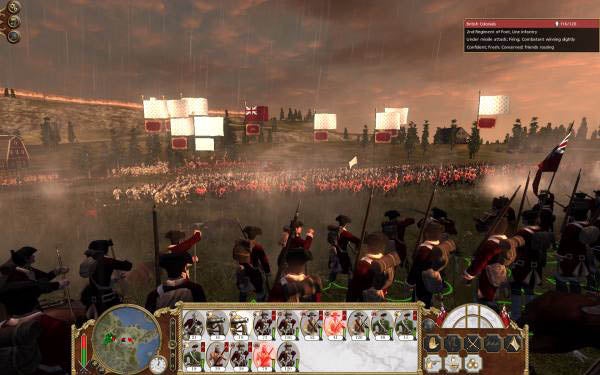
Other complaints? The system requirements are every bit as intimidating as the scale, and with some long loading times, frequent in-battle pauses and some painful waits while the actions of other factions are resolved in the turn-based campaign, Empire is the first game to make me wish for another 2GB of RAM in my slightly dated 2GB, quad-core, GeForce 8800 Ultra system. What’s more, I encountered a few crashes, the worst being a repetitive, fatal disaster during the AI turn of my Prussian campaign (what were you doing, Maratha Confederacy?) that effectively prevented me from going any further. I’m gracefully assuming that these are just the usual problems associated with pre-release software, but I suspect we might see a little patching before too long. While The Creative Assembly is at it, a few more battle scenarios wouldn’t go amiss.
Still, these niggles are counterbalanced by the fact that Empire keeps Total War firmly at the top of the tree in terms of strategy visuals, despite recent efforts from Dawn of War II or World in Conflict. The amount of detail in the land and naval battles is frequently breathtaking, and it’s good to see that more attempt has been made to give individual troops within a unit their own animations, adding to the sense that you’re a real general putting real men at risk. When you’re in the midst of a cavalry charge or advancing towards the smoking musket barrels of the enemy host, Empire is effortlessly cinematic, to the extent that it’s all too easy to take your eye off the tactical ball while you’re busy searching for the best camera angle. The naval battles can be equally impressive, particularly when the cannon balls are flying and masts and planks are blasted into splinters. Pay attention, purveyors of dishwater dull grand strategy games – this is how a modern strategy game should look!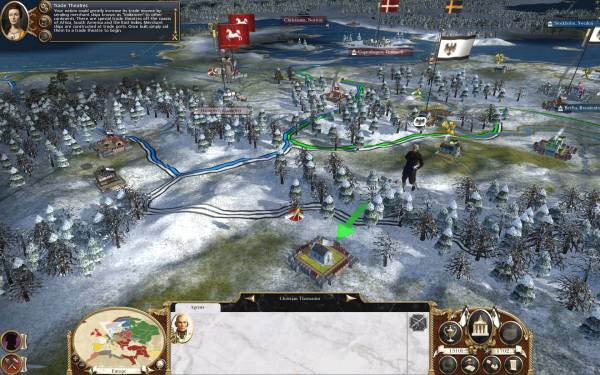
I won’t go on any longer. If you have the time and the energy for a strategy game of this scale, then Empire: Total War takes over from Medieval 2 as the best in the business. If you don’t, then something like Dawn of War II is arguably better for small bursts, but you’re still missing out on a classic. Can the series go onwards and upwards from here, or is this as good as Total War gets? I’m not sure, but given the fact that The Creative Assembly has raised the bar for strategy once again, I wouldn’t bet against it next time around.
”’Verdict”’
A new setting brings new features and new challenges, and an even bigger scale than Medieval 2. Empire is not just the best Total War, but the best epic strategy game, full-stop.

